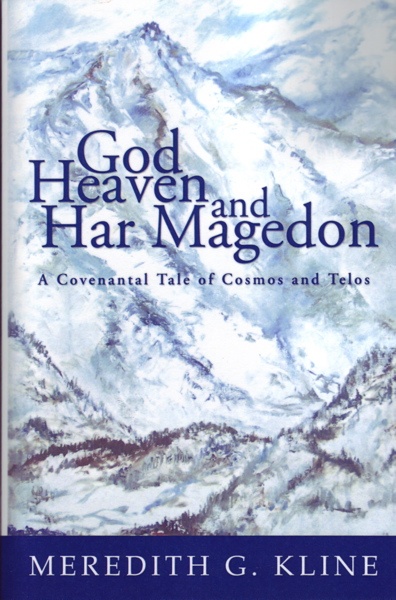
Meredith G. Kline’s God, Heaven, and Har Magedon: A Covenantal Tale of Cosmos and Telos is a fun book for the biblical scholar. Kline is still providing volumes of insight within a single sentence, but this time with much fewer hyphenated words. There was one paragraph with “altar-throne-temple-city” and the customary coined Klinisms like Glory-Spirit still show up from time to time. But, by and large, the sentences are a little more readable.
The book accomplishes its goal (telos). Tracing from the beginning of the cosmos to the telos of the theme of the Mount of Gathering from the Genesis Garden of Eden to Revelation’s resurrected Har Magedon. The biblical story is much more fascinating, as related by Kline, than all of the fictional tales out there on “Armaggedon.”
Like Alleluia should be Hallelu-yah (Hebrew for Praise Yah–the nickname of Israel’s God: Yahweh), this really should be transliterated as Har Magedon not Armaggedon. In both cases, the Greek has a rough breathing mark that corresponds to the guttural “h” sound but the English translators ignore. Har is Hebrew for hill or mountain, the latter being preferable here since this would the top of the world – figuratively speaking the highest mountain. And Magedon, Kline explains, is really Moed in Hebrew. Moed is Hebrew for assembly or gathering or congregation. The -on ending is common for Hebrew nouns. And the “g” sound is trying to transliterate a soft guttural letter ‘ayin that we usually do not pronounce at all. Moreover, John always explains transliterated words by giving a translation into Greek. Here that is found in the sentence too: “he gathered them to the place called in Hebrew har magedon.” Thus Har Magedon means Mount of Gathering. Kline also makes other points to solidify the argument, including where the phrase is the cosmic polar opposite to Hades or the pit. Thus the Heights of Zaphon on the one hand, and the depths of the pit on the other. The pit in Revelation is the Hebrew term Abbadon, the angel of the Abyss or Hades or Sheol, and often a synonym. It is found where we would expect the opposite of Har Magedon to be in Revelation.
Kline traces this motif from the mountain of Eden through Ararat through Sinai-Horeb through Jerusalem-Zion to the new Jerusalem. In the end, he provides a stellar explanation of the 3 and 1/2 times interval in Daniel and Revelation. And he avoids the errors of pre and postmillennialism and provides positive development of the so-called amillennial view, which really believes that the millennium is the period between AD 70 and Christ’s return. The 1000 years is time from the heavenly perspective, total and complete. But the time is 3 and 1/2 years and not FOUR from the perspective of the saints suffering persecution and martyrdom. Four is the wisdom number for complete. Thus, from the perspective of the saints, HOW LONG? will not be too long. We will not be utterly destroyed and consumed. Throughout this discussion, Kline remains Christocentric or better yet Christotelic in explaining the victory belongs to Jesus Christ on the Mount of Gathering at the end of the present world order.
For those of us who are living in the symbolic “3 and 1/2 years” that have taken from AD 70 into the present and possibly beyond, not knowing when Christ will return on the clouds, this book removes much of the confusion that others would frighten us with. May all the glory go to God. May He gather us to Har Magedon soon. Amen.
Recent Comments